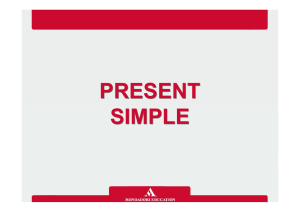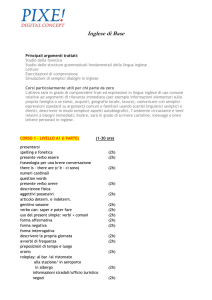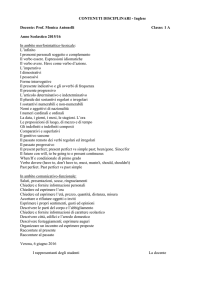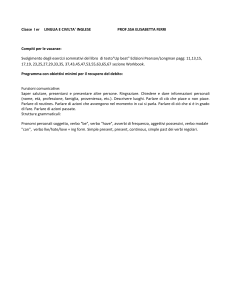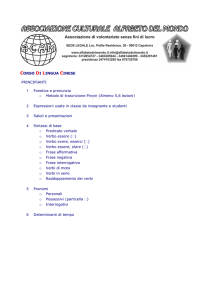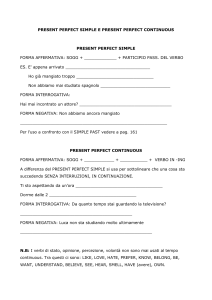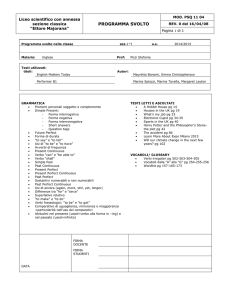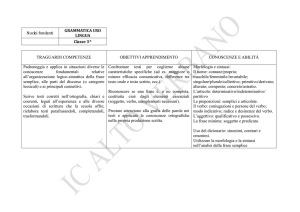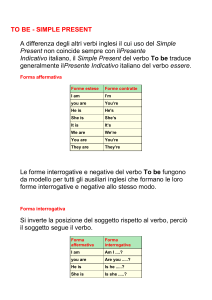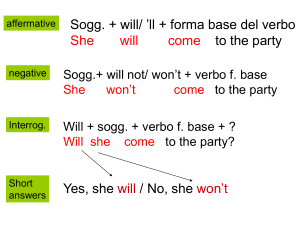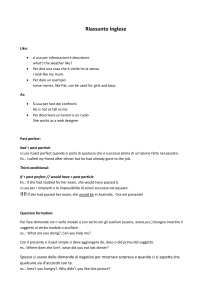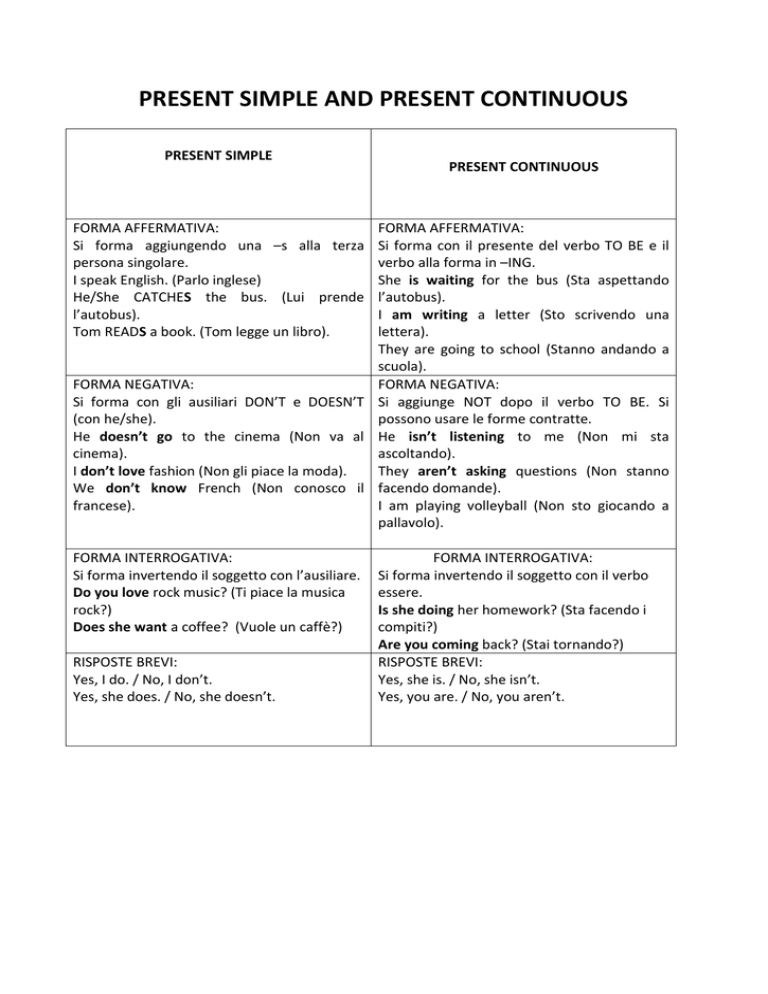
PRESENT SIMPLE AND PRESENT CONTINUOUS
PRESENT SIMPLE
PRESENT CONTINUOUS
FORMA AFFERMATIVA:
Si forma aggiungendo una –s alla terza
persona singolare.
I speak English. (Parlo inglese)
He/She CATCHES the bus. (Lui prende
l’autobus).
Tom READS a book. (Tom legge un libro).
FORMA AFFERMATIVA:
Si forma con il presente del verbo TO BE e il
verbo alla forma in –ING.
She is waiting for the bus (Sta aspettando
l’autobus).
I am writing a letter (Sto scrivendo una
lettera).
They are going to school (Stanno andando a
scuola).
FORMA NEGATIVA:
FORMA NEGATIVA:
Si forma con gli ausiliari DON’T e DOESN’T Si aggiunge NOT dopo il verbo TO BE. Si
(con he/she).
possono usare le forme contratte.
He doesn’t go to the cinema (Non va al He isn’t listening to me (Non mi sta
cinema).
ascoltando).
I don’t love fashion (Non gli piace la moda).
They aren’t asking questions (Non stanno
We don’t know French (Non conosco il facendo domande).
francese).
I am playing volleyball (Non sto giocando a
pallavolo).
FORMA INTERROGATIVA:
Si forma invertendo il soggetto con l’ausiliare.
Do you love rock music? (Ti piace la musica
rock?)
Does she want a coffee? (Vuole un caffè?)
RISPOSTE BREVI:
Yes, I do. / No, I don’t.
Yes, she does. / No, she doesn’t.
FORMA INTERROGATIVA:
Si forma invertendo il soggetto con il verbo
essere.
Is she doing her homework? (Sta facendo i
compiti?)
Are you coming back? (Stai tornando?)
RISPOSTE BREVI:
Yes, she is. / No, she isn’t.
Yes, you are. / No, you aren’t.
PRESENT SIMPLE
PRESENT CONTINUOUS
Il Present Simple è il presente delle ABITUDINI. Il Present Continuous si usa per parlare di
Lo usiamo per descrivere un’azione che facciamo un’azione che si sta svolgendo nel momento in
abitualmente:
cui parli:
1) I go to school (Vado a scuola).
1) I am writing a letter (Sto scrivendo
2) I live in Rome (Vivo a Roma).
una lettera).
3) I’m English (Sono inglese).
2) Judie is calling her mother (Judie sta
4) I watch TV (Guardo la TV).
chiamando sua madre).
3) My mother is cooking pasta (Mia
madre sta cucinando la pasta).
Il Present Simple si usa con AVVERBI (always, Per parlare di un’azione temporanea (non fissa,
often,
sometimes,
seldom,
never)
ed non stabile):
ESPRESSIONI DI FREQUENZA (every weekend,
1) I’m looking for a job (In questo
every week, every day, every month, on
periodo sto cercando lavoro, non per
Saturdays):
tutta la vita!!).
1) I usually write emails (Di solito scrivo
2) She is writing a new book (Adesso, in
email).
questo periodo, sta scrivendo un
2) Mark goes to the cinema every
nuovo libro).
weekend (Mark va al cinema tutti i
3) I’m living in Paris for work this month
fine settimana).
(Solo questo mese resterò a Parigi!)
3) We never read French novels (Non
legge mai romanzi francesi).
Il Present Simple si usa con i VERBI DI STATO, Per cambiamenti:
cioè quelli che esprimono sentimenti e pensieri
I’m getting fat (Sto ingrassando)
(know, like, want, love, hate, remember,
understand, have):
1) I feel angry (Sono arrabbiato).
2) I agree with her (Sono d’accordo con lei).
3) I love food (Mi piace il cibo).
4) I hate sports (Odio gli sport).
PAST SIMPLE AND PRESENT PERFECT
PAST SIMPLE
PRESENT PERFECT
FRASE AFFERMATIVA:
FRASE AFFERMATIVA:
La forma affermativa dei verbi regolari, si Per la frase affermativa, si usa il verbo TO HAVE +
forma aggiungendo –ED (a tutte le PAST PARTICIPLE del verbo.
1) I have had a shower (Ho fatto una
persone) alla fine del verbo.
doccia).
Per tutti gli altri verbi IRREGOLARI,
2) My mother has cooked pasta (Mia madre
bisogna prendere come riferimento la
ha preparato la pasta).
seconda colonna del paradigma dei verbi.
3) They have visited New York (Hanno
1) They were at home yesterday (Erano a
visitato New York).
casa ieri).
2) She bought a car last year (Ha comprato
una macchina l’anno scorso).
3) When he was a child, he lived in Paris
(Quando era piccolo, viveva a Parigi).
FRASE NEGATIVA:
Con il verbo TO BE si aggiunge NOT dopo
il verbo. Si usano soprattutto le forme
contratte:
I wasn’t at school yesterday (Non ero a
scuola ieri).
Con tutti gli altri verbi, si usa l’ausiliare
DIDN’T:
Jane didn’t go to the cinema last night
(Jane
non è andata al
cinema ieri sera).
FRASE NEGATIVA:
Per la frase negativa, si aggiunge semplicemente
NOT dopo HAVE. Si può anche usare la forma
contratta.
1) Mark hasn’t arrived (Mark non è
arrivato).
2) I haven’t found a job (Non ho trovato
lavoro).
FRASE INTERROGATIVA:
FRASE INTERROGATIVA:
Con il verbo TO BE (essere), si inverte il Per la forma interrogativa, si segue la regola
dell’inversione del soggetto con il verbo.
soggetto con il verbo:
1) Have you had your breakfast? (Hai fatto
Were you at school yesterday? (Ieri eri a
colazione?)
scuola?)
2) Has your mother been in Italy? (Tua
Per gli altri verbi, usa DID + SOGGETTO +
madre è stata in Italia?
FORMA BASE DEL VERBO:
Did you go to the cinema last night?
RISPOSTE BREVI:
Yes, I was. / No, I wasn’t.
Yes, I did. / No, I didn’t.
PAST SIMPLE
RISPOSTE BREVI:
Yes, I have. / No, I haven’t.
Yes, she has. / No, she hasn’t.
PRESENT PERFECT
Il Past Simple si usa per parlare di azioni precise Si usa per un passato recente. Per questo motivo,
successe nel passato. Per questo motivo si usa viene usato con espressioni come:
con espressioni come:
TODAY
AGO
THIS MORNING / THIS YEAR / THIS MONTH
YESTERDAY
/ THIS WEEK
LAST MONTH/ LAST YEAR/ LAST NIGHT/
RECENTLY
LAST WEEK
IN THE LAST FEW DAYS
IN 1989 / IN 2010
Esempio:
Per esempio:
I have eaten pasta two times this week
We ate pizza last night (Ieri sera abbiamo
(Ho mangiato la pasta due volte questa
mangiato la pizza).
settimana).
We didn’t go to school yesterday (Ieri non
Recently, I have read a lot of books (Ho
siamo andati a scuola).
letto molti libri di recente).
I lived with my parents two years ago (Due
anni fa vivevo con mia madre).
Per raccontare storie. Il Simple Past è usato nei Per parlare di esperienze di vita.
testi narrativi, in letteratura e in generale per
Esempio:
raccontare qualcosa che è successo nel passato (e
I have never been in Africa ( non sono
che finisce nel passato!).
mai stato/a in Africa).
Per esempio:
It’s the first time I have written a book (E’
When I was a child, I used to play football
la prima volta che scrivo un libro).
after school and ….. (Quando ero piccolo,
Have you ever ridden a horse? (Sei mai
giocavo a calico dopo la scuola e…)
andato a cavallo?).
Per parlare di abitudini nel passato. In questo Si usa per parlare di un’azione passata in cui non
caso, si usano gli avverbi di frequenza (always, specifica il tempo.
sometimes, often, usually, never).
Esempio:
Per esempio:
I have lost my keys (Quando ha perso le
I always walked to school (Andavo sempre
chiavi? Non lo sappiamo)
a piedi a scuola).
She has seen this movie. (Quando ha visto
il film? Ieri? Lo scorso mese? Non è
specificato)
Per formare domande con “When” (Quando).
Per formare domande con “How long” (per
When did you marry him? (Quando lo hai quanto tempo)
sposato?)
How long have you been in France?
(Per quanto tempo sei stato in Francia?
Per raccontare eventi storici (e quindi conclusi) e Con FOR e SINCE.
per parlare di persone defunte.
I have lived in Rome for five years (Vivo a
John Lennon died in 1980 (John Lennon
Roma da cinque anni).
è morto nel 1980).
I have lived in Rome since 2004 (Vivo a
The Second World War ended in 1945
Roma dal 2004).
(La seconda Guerra mondiale è finita nel 1945).
Si usa con espressioni come ALREADY (già), JUST
(appena), YET (ancora)
Esempi:
She has already paid the bill ( Ha già
pagato il conto)
She hasn’t paid the bill, yet. ( Non ha
ancora pagato il conto)
She has just paid the bill ( Ha appena
pagato il conto)
PRESENT PERFECT AND PRESENT PERFECT CONTINUOUS
PRESENT PERFECT
PRESENT PERFECT CONTINUOUS
FRASE AFFERMATIVA:
Per la frase affermativa, si usa il verbo TO
HAVE + PAST PARTICIPLE del verbo.
1)I have had a shower (Ho fatto una
doccia).
1) My mother has cooked pasta (Mia
madre ha preparato la pasta).
2) They have visited New York
(Hanno visitato New York).
FRASE NEGATIVA:
Per la frase negativa, si aggiunge
semplicemente NOT dopo HAVE. Si può
anche usare la forma contratta.
1) Mark hasn’t arrived (Mark non è
arrivato).
2) I haven’t found a job (Non ho
trovato lavoro).
FRASE INTERROGATIVA:
Per la forma interrogativa, si segue la
regola dell’inversione del soggetto con il
verbo.
1) Have you had your breakfast? (Hai
fatto colazione?)
2) Has your mother been in Italy?
(Tua madre è stata in Italia?)
RISPOSTE BREVI:
Yes, I have. / No, I haven’t.
Yes, she has. / No, she hasn’t.
FRASE AFFERMATIVA:
Per la frase affermativa, si usa HAVE/HAS
+ BEEN + VERBO ALLA –ING FORM.
1) I have been waiting for you for
three hours (Ti ho aspettato tre
ore).
2) She has been reading all day (Ha
letto tutto il giorno).
FRASE NEGATIVA:
Per la frase negativa, si aggiunge NOT
dopo il verbo avere. Si posso usare le
forme contratte.
1) She hasn’t been reading this novel
since September (Non legge
questo romanzo da Settembre).
FRASE INTERROGATIVA:
Per la frase interrogativa, vale la regola
dell’inversione.
1) How long have you been living
here? (Da quanto tempo vivi qui?)
2) Has she been waiting for him for a
long time? (Lo aspetta da tanto?)
RISPOSTE BREVI:
Yes, she has. / No, she hasn’t.
PRESENT PERFECT
PRESENT PERFECT CONTINUOUS
Il Present Perfect si usa con i VERBI DI STATO
(like, want, love, hate, remember,
understand, have, be, stop, break, decide,
forget).
1) I have loved a man for three years (Ho
amato un uomo per tre anni).
Il Present Perfect Continuous si usa per
indicare lo svolgimento di un’azione nel corso
del tempo. Vuole sottolineare che l’azione è
durata molto tempo. Si usa soprattutto con
SINCE, FOR, ALL DAY, ALL NIGHT LONG.
1) She has been reading for hours (Ha
2) She has been her since 9 o’ clock (Ѐ
stata qui dalle 9).
3) I have known my best friend since I
was three. (Conosco il mio migliore
amico da quando avevo tre anni).
4) They have had an accident (Hanno
avuto un incidente).
letto per ore).
2) They have been cooking all day
(Hanno cucinato tutto il giorno).
3) I have been waiting for three hours
(Ho aspettato tre ore).
4) I haven’t been driving since Christmas
(Non guido da Natale).
5) I’m bored. I have been studying all day
(Sono annoiato. Ho studiato tutto il
giorno).
Per fare domande con “How many” e “How Per fare domande con “How long” (Quanto
much” (Quanto), con “How often” (Quante tempo).
volte”
1) How long have you been waiting for
1) How often have you been in US?
me? (Da quanto tempo mi aspetti?)
(Quante volte sei stato negli Stati
Uniti?)
FUTURE SIMPLE AND TO BE GOING TO
FUTURE SIMPLE
TO BE GOING TO
FRASE AFFERMATIVA:
FRASE AFFERMATIVA:
Si forma con WILL + forma base del verbo.
Si forma con TO BE + GOING TO + VERBO
1) I will live in a bigger city (Vivrò in una FORMA BASE.
città più grande).
1) I’m going to study English literature at
2) In 2030, he will be 35 (Nel 2030, avrà 35
university (Ho intenzione di studiare
anni).
letteratura inglese all’università).
2) He is going to arrive (Sta per arrivare)
FRASE NEGATIVA
FRASE NEGATIVA:
Si forma con WON’T + forma base del verbo.
Si aggiunge NOT dopo il verbo essere. Si possono
1) In 2050, there won’t be books (Nel 2050, usare le forme contratte.
non ci saranno libri).
1) I’m not going to change my plans (Non
2) It won’t rain tomorrow (Domani non
ho intenzione di cambiare i miei
pioverà).
progetti).
2) They aren’t going to take the train (Non
hanno intenzione di prendere il treno).
FRASE INTERROGATIVA
FRASE INTERROGATIVA
Si forma con WILL + soggetto + forma base del Vale la regola dell’inversione del soggetto.
verbo.
1) How are you going to get there? (come
1) Will it rain tomorrow? (Pioverà domani?)
hai intenzione di arrivare lì?)
2) Will we pass our exam? (Supereremo
2) Is he going to see Mary? (Ha intenzione
l’esame?)
di vedere Mary?
RISPOSTE BREVI
RISPOSTE BREVI
Yes, it will. / No, it won’t.
Yes, he is. / No, he isn’t.
Yes, we will. / No, we won’t.
FUTURE SIMPLE
TO BE GOING TO
Il Future Simple si usa per fare previsioni nel Il futuro con “to be going to” si usa per indicare
futuro.
un’intenzione.
1) I’m going to win the match (Ho intenzione
1) Jane will love this dress (A Jane piacerà
di vincere la partita).
questo vestito).
2) He is going to meet his students (Ha
2) One day, everybody will speak English (Un
intenzione di incontrare i suoi studenti).
giorno, tutti parleranno inglese).
3) They are going to marry next summer
3) It won’t rain tomorrow (non pioverà
(Hanno intenzione di sposarsi la prossima
domani).
estate).
Per una promessa.
Per progetti.
1) I won’t forget your birthday (Non
1) He is going to be a singer (Ha intenzione di
dimenticherò il tuo compleanno).
diventare un cantante).
2) I will buy a cake for you (Ti comprerò una
2) They are going to learn Japanese (Hanno
torta)
intenzione di studiare il giapponese).
Per una decisione immediata, presa sul Per qualcosa che sta per accadere.
momento. In italiano, usiamo il presente.
1) She is going to cry (Sta per piangere).
1) I will take a coffee (Prendo un caffè).
2) It’s cold! I’m going to be ill. (Fa freddo! Mi
2) I will go and visit her (Vado a trovarla).
ammalerò).
3) I will buy this skirt (Compro questa
gonna).
Per esprimere opinion con “be sure”, “think”, Per una previsione certa e sicura.
“know”, “hope”, “probably”, “perharps”,
3) It’s too late. They aren’t going to come (Ѐ
“definitely”.
troppo tardi. Non verranno).
1) I’m sure he will love this book (Sono sicuro
che gli piacerà questo libro).
2) I will probably go with him (Probabilmente
andrò con lui).
MODAL VERBS
MUST / CAN’T
MAY / MIGHT / COULD
MUST si usa per parlare di qualcosa di cui si è
sicuri al 100%.
1) He lived in France when he was a child.
He must speak French. (Ha vissuto in in
Francia quando era piccolo. Sicuramente
parla il francese).
2) He has got expensive accessories. He
must be rich. (Ha accessori costosi.
Sicuramente è ricco).
MAY,
MIGHT
e
COULD
si
usano
indifferentemente per parlare di qualcosa di cui
non si è sicuri. Hanno tutti e tre lo stesso
significato, li usi per esprimere un “forse”, una
possibilità.
1) He is not at home. He might be at work.
(Non è a casa. Forse è al lavoro).
2) I saw them together. They could be
married. (Li ho visti insieme. Forse sono
sposati).
3) I heard a song. It may be my phone. (Ho
sentito una canzone. Forse è il mio
cellulare)
FORMA NEGATIVA: Si usa CAN’T.
FORMA NEGATIVA: Si usano MAY NOT o MIGHT
1) She hasn’t got a big house or an NOT.
expensive car. She can’t be rich. (Non ha
1) It may not be true. (Forse non è vero).
una casa grande o una macchina costosa.
2) I’m too tired. I might not come tonight.
Ѐ impossibile che sia ricco).
(Sono troppo stanca. Forse non vengo
stasera).
MUST/ HAVE TO
FORMA AFFERMATIVA
Alla forma affermativa, MUST e HAVE to
possono essere usati indifferentemente
perché non c’è differenza di significato.
Significano entrambi “DOVERE”.
1) I must call the doctor. / I have to call
the doctor. (Devo chiamare il medico)
2) He must move to London / He has to
move to London. (Deve trasferirsi a
Londra)
FORMA NEGATIVA
MUSTN’T
DON’T HAVE TO
Alla forma negative, “don’t have to” e
“mustn’t” hanno due significati diversi.
Si usa per indicare un divieto, un ordine
(solitamente un divieto per legge):
1) You musn’t smoke. (Ѐ vietato fumare)
2) You mustn’t park here. (Ѐ vietato
parcheggiare qui).
3) You mustn’t copy the test (Ѐ vietato
copiare il test).
Si usa per indicare qualcosa che non è
necessario.
1) He doesn’t have to work if he is ill.
(Non è necessario che lavori se sta
male).
2) You don’t have to come with me,
there is my mother. (Non è necessario
che venga con me, c’è mia madre).
RICORDA!!! Con HE/SHE si usa DOESN’T
HAVE TO.
FIRST, SECOND AND THIRD CONDITIONAL
(“IF CLAUSES”)
FIRST CONDITIONAL
SECOND CONDITIONAL
THIRD CONDITIONAL
FRASE PRINCIPALE: SOGGETTO FRASE PRINCIPALE: SOGGETTO FRASE PRINCIPALE: SOGGETTO
+ WILL + FORMA BASE DEL + WOULD/COULD + FORMA + WOULD + HAVE + PAST
VERBO
BASE DEL VERBO
PARTICIPLE DEL VERBO.
FRASE SECONDARIA: IF + FRASE SECONDARIA: IF + FRASE SECONDARIA: IF +
SOGGETTO + VERBO AL SIMPLE SOGGETTO + VERBO AL SIMPLE SOGGETTO + HAD + PAST
PRESENT
PAST
PARTICIPLE DEL VERBO.
1) If it rains ( = frase
secondaria con IF), I will
stay at home ( = frase
principale).
2) If I’m ill, I won’t go to
school (Se sto male, non
andrò a scuola).
RICORDA: Al posto di “IF” (se) si
può usare UNLESS (a meno
che), AS SOON AS (non
appena), UNTIL (fino a quando),
BEFORE (prima di):
1) I will go to the cinema
unless it rains (Andrò al
cinema a meno che non
piova).
2) They will call you as
soon as they arrive (Ti
chiameranno
non
appena arrivano.
1) If I were American ( =
frase secondaria), I
would live in New York (
= frase principale).
2) If I lived in France, I
would speak a good
French (Se vivessi in
Francia, parlerei un
buon francese).
RICORDA:
Nella frase secondaria, il
verbo essere diventa
sempre WERE (con tutte
le persone, I, you, he,
she, we, you, they);
Si
usa
spesso
l’espressione IF I WERE
YOU (Se fossi in te):
If I were you, I would
study more (Se fossi in
te, studierei di più).
WOULD può essere
contratto con ‘d:
1) If I had had money (=
frase secondaria), I
would have bought a
car (= frase principale).
2) If you had come to the
party, you would have
met Mark (Se fossi
venuto alla festa, avresti
conosciuto Mark).
3) I will eat before I start
studying.
(Mangerò
prima di iniziare a
studiare).
SI USA PER PARLARE DI
FATTI CHE POTREBBERO
ACCADERE NEL FUTURO.
If I were you, I’d study
more.
SI USA PER PARLARE DI
SOGNI E DESIDERI CHE
NON
SI
POSSONO
REALIZZARE
NEL
PRESENTE.
SI USA PER ESPRIMERE
SITUAZIONI
POSSIBILI
NEL PASSATO MA CHE
NON
SONO
PIÙ
POSSIBILI
NEL
PRESENTE.
WISH
SOGGETTO + WISH + SOGGETTO + SIMPLE PAST
SOGGETTO + WISH + SOGGETTO + PAST
PERFECT
I wish I lived in Japan. (VORREI vivere in I wish I had studied more at school. (VORREI
Giappone)
aver studiato di più a scuola)
He wishes he didn’t live in Italy. (VORREBBE non I wish he hadn’t gone to the party. (VORREI che
vivere in Italia)
non fosse andato alla festa)
I wish I could fly. (Vorrei saper volare)
I wish I had gone to bed earlier. (VORREI essere
andato a letto prima)
SI USA PER ESPRIMERE UN DESIDERIO CHE SI USA PER ESPRIMERE UN RIMPIANTO,
VORRESTI REALIZZARE.
QUALCOSA CHE NON PUOI PIÙ FARE.
THE PASSIVE
Nelle frasi passive è l’oggetto che compie l’azione.
Esempio in italiano:
Il pittore dipinge il quadro (frase attiva)
Il quadro è dipinto dal pittore (frase passiva)
PASSIVE FORM
SIMPLE PRESENT
TO BE (coniugato al presente) + PAST
PARTICIPLE DEL VERBO
Scotch whisky is made by Scottish. (Lo
Scotch è fatto dagli scozzesi)
SIMPLE PAST
Breakfast is served every morning. (La
colazione è servita tutti i giorni)
TO BE (coniugato al Simple Past) + PAST
PARTICIPLE DEL VERBO
PRESENT PERFECT
The Importance of Being Earnest was
written by Oscar Wilde. (L’Importanza
di chiamarsi Ernesto fu scritto da O.
Wilde).
My phone was stolen yesterday. (Il
mio telefano è stato rubato ieri).
HAVE/HAS (con he e she) + BEEN + PAST
PARTICIPLE DEL VERBO
PRESENT CONTINUOUS
The silver medal has been won by
Italy. (La medaglia d’argento è stata
vinta dall’Italia).
Several houses have been sold.
(Diverse case sono state vendute).
TO BE (coniugato al presente) + BEING + PAST
PARTICIPLE DEL VERBO.
The English grammar is being
explained by the teacher. (La
grammatica inglese è spiegata dalla
prof.)
PAST CONTINUOUS
TO BE (coniugato al Simple Past) + BEING +
PAST PARTICIPLE DEL VERBO
I was a child when these houses were
being built (Ero un bambino quando
queste case venivano costruite).
WILL + BE + PAST PARTICIPLE DEL VERBO
FUTURE SIMPLE
RICORDA !!
These cookies will be served at the
party (Questi biscotti saranno serviti
alla festa)
1) Quando
devi
specificare
il
complemento d’agente (cioè devi dire
“da me”, “da mia madre”, “da
Picasso”), devi usare la preposizione
BY: This novel was written by Jane
Austen (Questo romanzo è stato
scritto da Jane Austen).
2) I tempi verbali della forma passiva
seguono le stesse regole di quelli della
forma attiva. Quindi, userai il Present
Simple per le abitudini, il Present
Continuous per parlare di qualcosa che
si sta svolgendo adesso, il Simple Past
per un passato concluso e specifico
ecc…
REPORTED SPEECH
Il “reported speech” è il discorso indiretto in inglese. Fate attenzione! Anche se il discorso diretto è
al PRESENTE, il “reported speech” sarà al PASSATO.
DIRECT SPEECH
PRESENT SIMPLE
1) “I go to the cinema every Saturday”
2) “She doesn’t read books”
PRESENT CONTINUOUS
1) “Monica is watching TV”
2) “They are listening to rock music”
PRESENT PERFECT
1) “They have lost their keys”
2) “My mother has lived in Rome for 10
years”.
PAST SIMPLE
1) “I ate a pizza yesterday”
2) “My boyfriend had a meeting last week”
REPORTED SPEECH
PAST SIMPLE
1) She said (that) she went to the cinema
every Saturday. (Disse che andava al
cinema tutti I Sabati).
2) He said (that) she didn’t read books.
PAST CONTINUOUS
1) My brother said (that) Monica were
watching TV. (Mio fratello ha detto che
Monica stave guardando la TV).
2) My dad said (that) they were listening to
rock music.
RICORDA!!!
Le seguenti espressioni, vanno trasformate in
questo modo al reported speech:
NOW THEN, AT THAT MOMENT
TODAY THAT DAY
TONIGHT THAT NIGHT
THIS MORNING THAT MORNING
THIS EVENING THAT EVENING
PAST PERFECT
1) She said (that) they had lost their keys.
(Ha detto che avevano perso le chiavi).
2) He said (that) his mother had lived in
Rome for 10 years. (Disse che sua madre
aveva vissuto a Roma per 10 anni).
PAST PERFECT
1) She said (that) she had eaten a pizza the
day before. (Disse che aveva mangiato
una pizza il giorno prima).
2) She said (that) her boyfriend had had a
meeting the previous week. (Disse che il
suo ragazzo aveva avuto un incontro di
lavoro la settimana prima).
RICORDA!!!
Se nel discorso diretto ci sono queste formule, al
reported speech diventano:
YESTERDAY THE DAY BEFORE
LAST WEEK THE PREVIOUS WEEK
LAST MONTH THE PREVIOUS MONTH
LAST YEAR THE PREVIOUS YEAR
AN HOUR AGO AN HOUR BEFORE
CONDIZIONALE CON WOULD
FUTURO CON WILL
1) “I will go to the States”
2) “It won’t rain”
1) She said (that) she would go to the
States. (Disse che sarebbe andata negli
Stati Uniti).
2) He said (that) it wouldn’t rain. (Disse che
non avrebbe piovuto).
RICORDA!!!
Le seguenti espressioni, vanno trasformate in
questo modo al reported speech:
TOMORROW THE NEXT DAY
NEXT WEEK THE FOLLOWING WEEK
NEXT MONTH THE FOLLOWING MONTH
NEXT YEAR THE FOLLOWING YEAR
RICORDA!! CON IL REPORTED SPEECH PUOI USARE “SAY” E “TELL” MA C’Ѐ UNA DIFFERENZA:
SAY
SAY è sempre seguito da THAT.
TELL
TELL è sempre seguito dai PRONOMI (ME,
YOU, HIM/HER, US, THEM):
She said that he was a good friend. (Disse
che era un buon amico).
She told us he was a good friend (Ci disse
che era un buon amico).
My mother said that they were eating at
restaurant. (Mia madre disse che stavano My mother told me they were eating at
mangiano ristorante.
restaurant. (Mia madre mi disse che stavano
mangiando al ristorante).
REPORTED QUESTIONS
Le “reported questions” sono le domande riportate al discorso indiretto. Anche in questo caso, le
domande al presente vengono trasformate al PASSATO.
DIRECT SPEECH
REPORTED SPEECH
PRESENT SIMPLE
PAST SIMPLE
“Does she go to the party?”
He told if she went to the party. (Chiese se
andava alla festa).
PRESENT CONTINUOUS
PAST CONTINUOUS
“Are they reading Pride and Prejudice?”
She asked if they were reading Pride and
Prejudice. (Chiese se stavano leggendo Orgoglio
e Pregiudizio).
PRESENT PERFECT
PAST PERFECT
“Have you ever been in Japan?
He asked if they have ever been in Japan.
(Chiese se fossero mai stati in Giappone).
PAST SIMPLE
PAST PERFECT
“Did you go to the cinema yesterday?”
They asked if I went to the cinema the day
before. (Chiesero se fossi andata al cinema il
giorno prima).
FUTURO CON WILL
CONDIZIONALE CON WOULD
“Will everybody go on holiday?”
He asked if everybody would go on holiday.
(Chiese se tutti sarebbero andati in vacanza).

